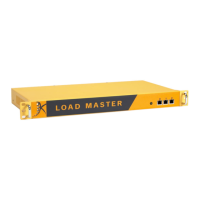
Do you have a question about the KEMP Technologies LoadMaster 1500 and is the answer not in the manual?
| Brand | KEMP Technologies |
|---|---|
| Model | LoadMaster 1500 |
| Category | Network Hardware |
| Language | English |
Introduces the document and provides general information.
Explains the concept, benefits, and considerations of Load Balancing.
Details various network configurations like One-Armed and Two-Armed.
Covers networking topics such as S-NAT and default gateway configuration.
Explains single unit setup and High Availability (HA) cluster configurations.
Describes load balancing algorithms like Round Robin and Least Connection.
Explains connection persistence based on source IP addresses.
Explains content-based persistence using cookies, URL, or SSL Session ID.
Details enabling and configuring SSL acceleration functionality.
Describes how to define rules for content-based request routing.
Covers methods for monitoring real server and service availability.
Explains how to use SNMP for monitoring LoadMaster metrics and events.
Describes the process of installing software updates and patches.
Covers licensing, backup, restore, and system recovery.
Contains supplementary information, including an API for adaptive balancing.
Initial steps and prerequisites for installing the LoadMaster.
Step-by-step guide for the initial setup of a standalone LoadMaster.
Detailed instructions for configuring an HA cluster of LoadMasters.
A streamlined process for initial LoadMaster configuration.
Overview of the LoadMaster's main menu structure and navigation.
Lists and explains the primary commands available at the CLI top level.
Details commands for configuring adaptive scheduling parameters.
Covers commands for configuring health check parameters for servers.
Explains commands for managing content rules for request routing.
Details commands for editing specific content rules.
Lists commands for managing Virtual Services (VIPs).
Explains commands for configuring individual Real Servers.
Defines key terms and abbreviations used in the manual.
Provides a quick guide to creating virtual services using the WUI.
Offers a quick reference to the Load Master WUI menu structure and navigation.